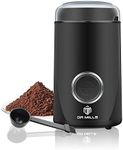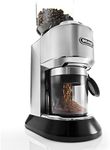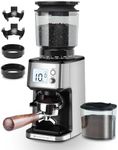Buying Guide for the Best Coffee Grinders
Choosing the right coffee grinder can make a big difference in the taste and quality of your coffee. The grinder you pick should match your brewing method, your taste preferences, and how much effort you want to put into grinding. Understanding the key features will help you find a grinder that fits your daily routine and helps you enjoy your coffee just the way you like it.Grinder Type (Blade vs Burr)The grinder type refers to the mechanism used to crush the coffee beans. Blade grinders use spinning blades to chop beans, while burr grinders use two abrasive surfaces to crush them evenly. Burr grinders are generally preferred because they produce a more consistent grind size, which is important for balanced flavor extraction. Blade grinders are usually cheaper and simpler but can result in uneven grinds. If you want better-tasting coffee and use methods like espresso or pour-over, a burr grinder is a better choice. For casual use or if you’re not picky about grind consistency, a blade grinder can be sufficient.
Grind Size SettingsGrind size settings determine how fine or coarse your coffee grounds will be. This is important because different brewing methods require different grind sizes for optimal flavor. Some grinders offer just a few settings (coarse, medium, fine), while others have many steps for precise control. If you use multiple brewing methods (like French press, drip, and espresso), look for a grinder with a wide range of settings. If you always use the same method, you can choose a simpler grinder with fewer options.
CapacityCapacity refers to how much coffee the grinder can hold and grind at one time. This matters if you often make coffee for several people or want to grind a lot at once. Small-capacity grinders are compact and good for single servings, while larger ones are better for families or entertaining guests. Think about how much coffee you usually make at once to decide what capacity fits your needs.
Manual vs ElectricManual grinders require you to turn a handle to grind the beans, while electric grinders do the work at the push of a button. Manual grinders are quieter, portable, and often more affordable, but they require more effort and time. Electric grinders are faster and more convenient, especially if you make coffee often or in larger amounts. Choose a manual grinder if you value portability or enjoy the process, and an electric one if you want speed and ease.
Ease of CleaningEase of cleaning refers to how simple it is to take apart and clean the grinder. Coffee oils and fine grounds can build up and affect flavor or performance. Some grinders have removable parts or come with cleaning tools, making maintenance easier. If you want to keep your grinder in good shape with minimal hassle, look for one that’s easy to disassemble and clean.
Noise LevelNoise level is how loud the grinder is when in use. Electric grinders, especially powerful ones, can be quite noisy, which might be an issue if you make coffee early in the morning or in a quiet environment. Manual grinders are much quieter. If noise is a concern for you, consider a manual grinder or look for electric models known for quieter operation.

















